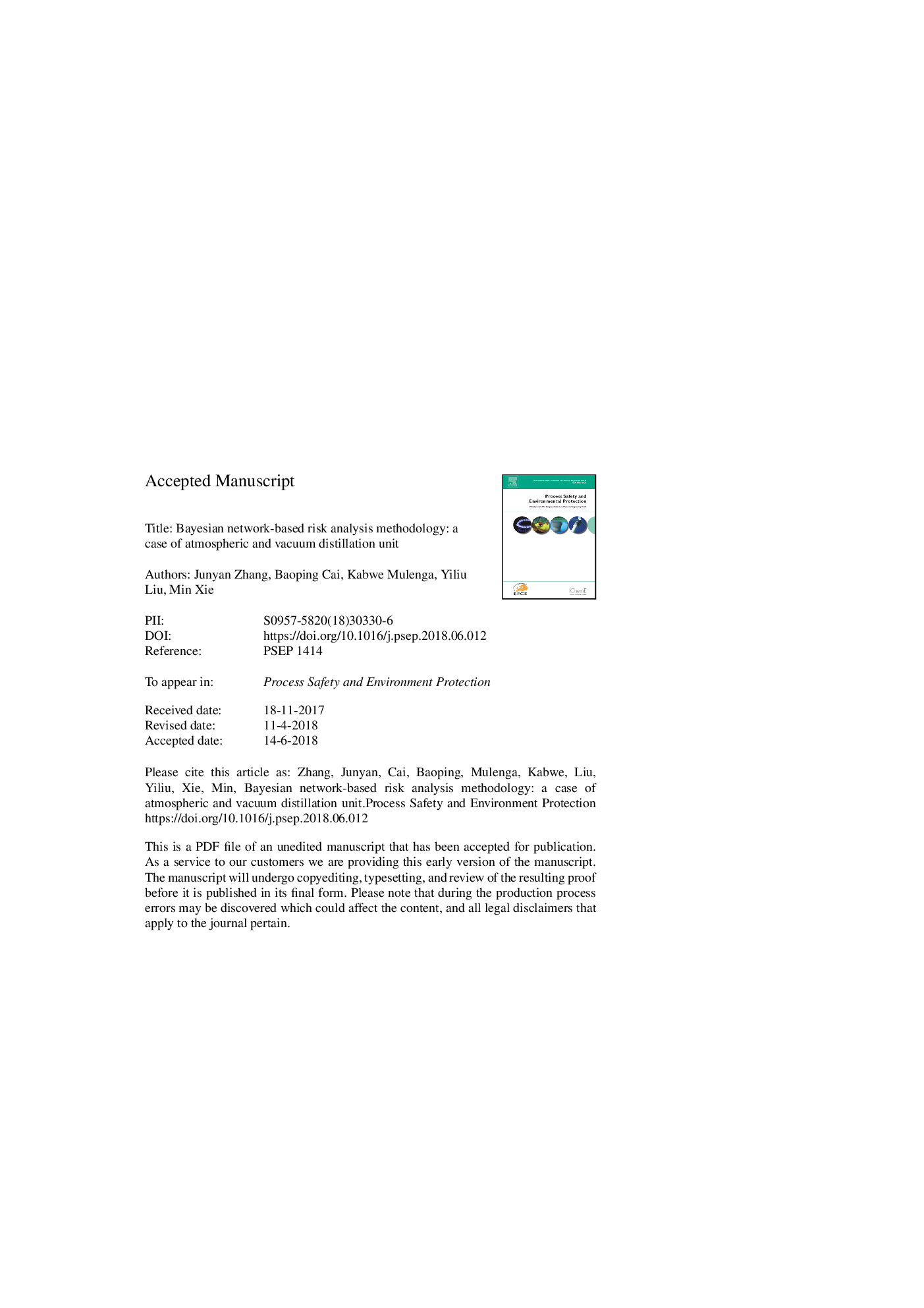| کد مقاله | کد نشریه | سال انتشار | مقاله انگلیسی | نسخه تمام متن |
|---|---|---|---|---|
| 6974030 | 1453322 | 2018 | 34 صفحه PDF | دانلود رایگان |
عنوان انگلیسی مقاله ISI
Bayesian network-based risk analysis methodology: A case of atmospheric and vacuum distillation unit
ترجمه فارسی عنوان
روش تجزیه و تحلیل ریسک مبتنی بر شبکه بیزی: مورد واحد تقطیر جوی و خلاء
دانلود مقاله + سفارش ترجمه
دانلود مقاله ISI انگلیسی
رایگان برای ایرانیان
کلمات کلیدی
تحلیل ریسک، شبکه های بیزی، گیاه شیمیایی، مدل سلسله مراتبی سه لایه،
ترجمه چکیده
حوادث شیمیایی و پتروشیمی، مانند آتش سوزی و انفجار، اغلب اتفاق نمی افتد اما عواقب قابل توجهی دارند. این حوادث نه تنها ایمنی انسان را به خطر می اندازد، بلکه موجب زیان های قابل توجه اقتصادی و آلودگی محیط زیست می شود. پیچیدگی در حال افزایش زیرساخت های شیمیایی الزامات پیشگیری از خطر را افزایش می دهد. بنابراین تجزیه و تحلیل ریسک برای سیستم های پتروشیمی در کمک به تحلیل گران یافتن ضعف ترین فرآیند در کل سیستم ضروری است و برای تقویت روند و بهبود ایمنی مورد استفاده قرار می گیرد. تجزیه و تحلیل ریسک قبلا مورد بررسی قرار گرفته است؛ با این حال، روش های سنتی محدودیت دارند. این مطالعه پیشنهاد روش شناسی مبتنی بر شبکه های بیزی را با ارائه مدل برای تجزیه و تحلیل ریسک سیستم ارائه می دهد. این رویداد به سه دسته تقسیم می شود: علت، حادثه و حادثه، با توجه به اهمیت و بنابراین، مدل به عنوان یک ساختار سه لایه تجزیه و تحلیل می شود. کاربرد روش شناسی با تجزیه و تحلیل تقطیر خلاء و واحد جوی نشان داده شده است. یک روش استدلال دقیق برای کشف علیت و احتمال در حوادث استفاده می شود. پس از کشف رابطه بین علل و حوادث، اطلاعات متقابل و واریانس باورها محاسبه می شود تا حساسیت ترین رویداد را در یک تصادف پیدا کند. در ادامه، به منظور تقویت عملیات برای جلوگیری از حوادث پیشنهاد می شود. این مطالعه ممکن است به کمپانی ها کمک کند هزینه کاهش خطر را کاهش دهد.
موضوعات مرتبط
مهندسی و علوم پایه
مهندسی شیمی
بهداشت و امنیت شیمی
چکیده انگلیسی
Chemical and petrochemical accidents, such as fires and explosions, do not happen frequently but have considerable consequences. These accidents compromise not only human safety but also cause significant economic losses and environmental contamination. The increasing complexity of chemical infrastructures increases the requirements of risk prevention. Thus, risk analysis for petrochemical systems is essential in helping analysts find the weakest process in the entire system and be used to strengthen the process and improve safety. Risk analysis has been previously studied; however, traditional methods have limitations. This study proposes a methodology that is based on Bayesian networks by giving a model for system risk analysis. The event is classified into three categories; cause, incident, and accident, according to criticality and thus, the model is analyzed as a three-layered structure. The application of the methodology is demonstrated by analyzing a vacuum distillation and an atmospheric unit. An exact reasoning method is used to infer the causality and probability within the events. After inferring the relationship between causes and accidents, mutual information and variance of beliefs are calculated to find the most sensitive event in an accident. Subsequently, means of strengthening operations to prevent accidents are suggested. This study may help companies decrease the cost of risk reduction.
ناشر
Database: Elsevier - ScienceDirect (ساینس دایرکت)
Journal: Process Safety and Environmental Protection - Volume 117, July 2018, Pages 660-674
Journal: Process Safety and Environmental Protection - Volume 117, July 2018, Pages 660-674
نویسندگان
Junyan Zhang, Baoping Cai, Kabwe Mulenga, Yiliu Liu, Min Xie,
